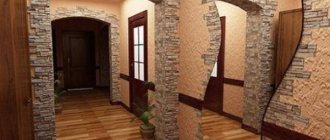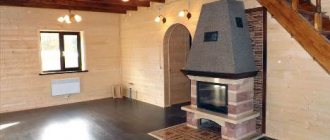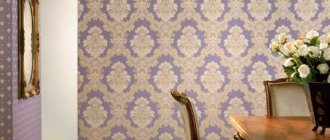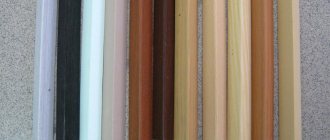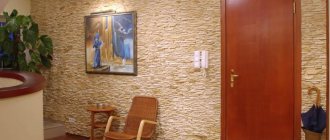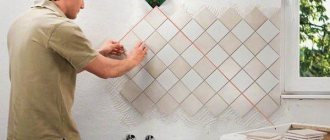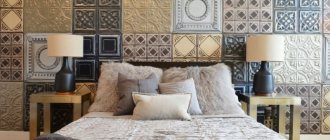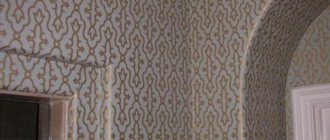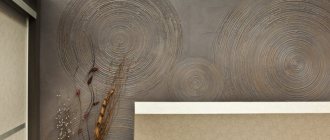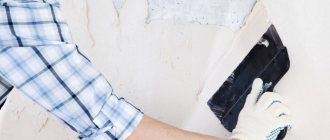Marble cladding today is carried out using different technologies, there are a great many of them. Depending on the weight of the finish and its size, a certain amount of tools will be prepared and an algorithm for carrying out the work will be selected. Marble is a natural stone that is environmentally friendly. It is offered for sale in a wide variety of sizes and shades.
Marble in the interior
It has a rich palette, polishes well, and has a unique pattern. Therefore, from ancient times to the present day, marble has been used in interior design for:
- Design of internal and external walls.
- Finishing of plinths, staircase steps, door and window openings.
- Floor coverings.
- Design of fireplaces, decorative hearths.
- Finishing of swimming pools, saunas, bathrooms.
- Manufacturing of countertops and kitchen aprons.
- Production of furniture, interior parts (columns, plinths, statues, fountains).
Hall
How to choose?
Marble is an expensive material, which encourages unscrupulous sellers to falsify it. Often in construction markets there are slabs that do not actually have the characteristics of natural stone. It is difficult to notice the difference from the outside.
What to pay attention to:
- find the place where the slab is chipped and look at the real section - in the middle the fake will have a dense layer of limestone, pressed clay or flour, and the natural stone consists entirely of rock of the same color with veins as the polished part;
- if you run your hand over the surface, it will be smooth, any unevenness is a place with a thin layer of varnish, and therefore is susceptible to destruction and damage in the first place;
- the slab must be straight - before receiving the material, you need to check each pack;
- outwardly it will be good if the pattern is uniform and the slabs after installation will create an overall picture;
- the color and thickness of the marble matter - the foundation must be able to withstand the weight of the cladding, so the width is calculated in advance when creating the project, the shade must be harmoniously combined with the facade;
- the conditions under which the material can be used must be specified in advance; pay attention to moisture and frost resistance.
Marble chips must have the same characteristics regarding moisture and temperature cycles. Main characteristics:
- Strength.
- Flakiness (number of granules identical in appearance).
- Frost resistance.
- Impurity content.
Advantages
Natural natural material. With minimal processing (sawing, polishing), marble has many advantages:
- Durability. Serves for centuries. It is difficult to damage. The appearance and design are preserved despite sunlight, frost, and heat.
- Strength. Marble is heavy and hard. Holds polish very well. Abrasion and significant mechanical loads (when laid on the floor) are not dangerous.
- Beauty. The material has a texture of one color or a combination of several. The number of colors is large. The whole spectrum - from black to white.
- Uniqueness of the view. The texture is created by nature accidentally. No two slabs are alike. This makes a room decorated with marble unique.
- Environmentally friendly. Harmless to humans and pets. Does not emit harmful fumes or radiation. Good dielectric.
- Compatible with all decor styles. Used for decoration in classical and modern styles. Empire and Renaissance do not shy away from this material.
Kitchen
What kind of material is this?
Marble is a natural stone, environmentally friendly and safe. It is distinguished by an abundance of veins, which is why a beautiful pattern appears on its surface. It comes in different colors from milky white to rare black (especially beautiful pink and green). For facing work it is supplied in the form of slabs of different sizes.
Positive qualities of marble:
Low level of hygroscopicity. Marble can be used in high humidity, it is safe and will protect the foundation and base from destruction.- Durability. The stone is not afraid of impacts, scratches, does not crack over time and does not fall into pieces.
- The slabs are easy to care for. They are resistant to chemical cleaning agents, do not react, and maintain their integrity.
In composition, marble is a metamorphic rock, most of which is dolomite recrystallized with limestone. Thanks to the variety of patterns, it creates a unique appearance of the building. In addition, it has bactericidal properties; mold and mildew do not appear on it.
Unfortunately, it does not tolerate frost well , but there are special varieties that are not destroyed by temperature changes. Let's remember the facades of St. Petersburg, which have withstood harsh weather conditions for centuries.
The main feature of marble is its mirror-like shine. There are different grain sizes: fine, coarse and medium. Requires care.
Differences from marble chips
Marble chips are a by-product after processing natural stone. In terms of composition, these are uneven granules of different sizes from 1 to 10 mm; 2.5-5 mm is suitable for cladding. When facing, it creates a volumetric effect and is used for decoration.
What are the benefits of marble chips when finishing a plinth:
- "Breathing" walls. The material allows air to pass through and prevents harmful substances and microorganisms from forming on the surface of the base of the building.
- Can be applied to various materials: concrete, brick, wood, etc.
- Protection from precipitation and moisture from the ground. Calmly tolerates temperature changes and does not deteriorate from sunlight. Does not allow wind to pass through and is not destroyed by humidity.
- Durable.
It is not recommended to use in conjunction with metal structures; metal chips promote corrosion. After installation, the material becomes homogeneous, it is impossible to dismantle it, only together with a piece of the wall.
It differs from ordinary marble in appearance and density. Marble is a monolithic slab, and crumbs are granules from it mixed with concrete or polymer, imitating the texture of stone.
Differences between crumbs and marble in properties:
- not so durable;
- less durable;
- it doesn’t look so beautiful, it’s simpler;
- feels like plastic;
- cannot be sanded.
How artificial marble is created:
- Liteva. Marble chips are poured into the desired shape (in the specific case of tiles) and filled with epoxy resin.
- Oselkovy. A gypsum mass is created and mixed with marble chips. The resulting mixture is diluted with glue and water, laid out on the base until completely hardened in a continuous layer. After the procedure there are no stitches at all.
- Flexible. A mixture of marble chips and epoxy resin is applied to a plastic board with a thin layer of 2-3 mm. After the mixture hardens, a flexible coating for the basement walls is obtained.
Application area
The material is used to decorate public and private houses. This stems from its decorative appearance, variety of varieties, and ease of processing.
The last thing is absolutely true - marble is easy to cut (with diamond discs) and polished. Individual elements such as cornices and medallions are fixed with stone glue and hidden pins.
Stair steps, hall floors, columns, fireplace portals are made of marble slabs. This stone is used for the production of decorative elements - statues, baguettes, furniture countertops. Finish the interiors of swimming pools, baths, saunas.
Bathroom
Surface preparation
Before finishing walls with marble slabs, surface preparation must be carried out. It should include the following types of work:
- surface leveling. This is done using drywall, plaster or cement mortar. However, drywall and plaster are used only when the slabs are light in weight. When choosing plaster, you should use two types - starting and finishing. After applying the leveling layer, you need to wait for it to dry completely;
- its further strengthening;
- cleaning the surface from dirt;
- priming with special means that increase the adhesion of the wall surface and the facing material.
Remember that proper surface preparation is the key to fast and high-quality further work.
Wall decoration
A simple process that requires accuracy, a lot of effort and time. If an amateur craftsman is not confident in his abilities, he should turn to professionals for help. If installation is incorrect, repeated repairs and loss of expensive material are inevitable. The process consists of two equivalent stages - preparation of surfaces, fastening of stone slabs.
Fireplace
Preparing walls for cladding
Preparing walls for installation of tiles consists of the following steps:
- Leveling surfaces. Removing plaster down to the brick or concrete base. Using a power tool and a hand hammer (mallet, chisel) remove irregularities - sagging mortar, protruding fasteners, seams. When working with tiles of small size and weight (about 30-40x30-40 cm width-height, 1-1.5 cm thickness), they can be mounted on a plasterboard base. It is installed according to the usual scheme.
Advice! When leveling walls with drywall, use a waterproof type.
- Strengthening. The finished plasterboard surface is covered with a solution, and a metal mesh is imprinted into it. It is covered with an even, thin layer of cement mortar. If the tiles are mounted on a brick wall, the mesh is installed directly on it. This strengthens and further smoothes the surface.
- Cleaning. After the solution has dried, the surface is treated with construction brushes, achieving a smooth surface. The resulting dust is removed with a construction vacuum cleaner.
- Padding. The finished flat wall is covered with soil. This facilitates fastening and protects the wall from the external environment.
Fireplace Hall
Wall mounting
There are three types of plate fastening:
- For cement mortar. Plastic or metal clips are attached to the wall. Blind holes are drilled in the stone slabs from the reverse side in appropriate places. The wall is covered with an even layer of cement mortar. The tiles are pressed to the plane and at the same time fixed with clips. After the first row, a second one is attached above it - so up to the ceiling. The amount of mortar on the wall must correspond to the type of masonry - with or without a seam. In the first case, a pigment is added to the solution to match the color of the stone.
- For stone glue. This method is the simplest and is suitable for small, lightweight marble tiles. Glue is applied to the wall and tiles. Then it is attached to the desired place. The glue hardens and the stone tiles hold firmly. Clips are not used.
- On separate metal fasteners. The method is the most labor-intensive and expensive, it allows you to install slabs of several square meters in area, up to 20 cm thick. It consists of installing a ventilated metal frame against the wall. Stone slabs are attached to it. Such fasteners relieve the load from adjacent elements and make the structure durable.
Bedroom
Installation
Installation work necessarily involves preparing a saw for cutting marble. You will also need:
- notched spatula;
- rubber mallet;
- roulette;
- corner;
- Bulgarian;
- Grinder;
- electric drill.
There should be no cracks, peelings or defects in the working area. It is also important to rid the base of fungus and mold. It is necessary to ensure that the humidity of the base is not higher than 0.6%.
Installing slabs on concrete
When installing on concrete, it is important to make sure that it was laid long enough and that its surface has dried well. Otherwise, you will find that the mortar and concrete will shrink at different rates, which will cause damage to the finish. The base must be checked for residual moisture and the degree of readiness for further work by measuring the humidity level with a special device. If you use empirical methods, for example, film, this will only allow you to get approximate results.
Glue installation
When carrying out installation work using a liquid composition, glue is applied to a small area and a marble slab using a notched trowel. After applying it to the surface, you need to press firmly on the tile, but do not allow it to move. The seams should be straight, horizontal and vertical. After laying, the surface is left for up to a day to dry the glue. The joints are then grouted using Portland cement.
Mechanical method
Having chosen a suitable design for your home, you can begin cladding the walls. Marble can be installed not only with glue, but also mechanically. In this case, not the highest requirements are placed on the base, because the products will be installed on the frame guides.
No surface leveling is required. Between the wall and the frame there will be a distance in which a whole heat-, steam- and sound-insulating pie needs to be laid. It will be necessary to mark and install the frame. The latter can consist of stainless galvanized or durable aluminum. After the work with the frame is completed, you can begin fastening the functional structures. This is true when it comes to cladding external walls.
Materials: analogues of marble
Despite all the advantages and attractiveness of marble, its high price discourages its use. Expensive material is replaced with affordable imitations. Three popular options:
- Plaster. They use Venetian. It is applied in several layers of different shades and colors, then they are mixed - manually forming a pattern that imitates stone. If the homeowner does not have experience with this type of plaster, it is worth hiring a professional. You need to buy high-quality plaster mixtures. This guarantees high quality results.
- Ceramic tile. There are many varieties of different price groups on the market. There are tiles for the floor and walls. Their installation is simple and accessible to a technician without experience. The main thing is to level the surface of the wall or floor well and apply the proper amount of glue.
Advice! Ceramic tiles often weigh as much as the marble tiles they imitate. Therefore, it is necessary to balance the strength of the mounting surface and the weight of the material. For reliability, high-quality glue and plastic mounting clips are used.
- PVC panels. The most budget-friendly and simplest finishing option. The panels are moisture resistant. They tolerate exposure to sunlight well. They are distinguished by their low weight. Installation involves fastening the panels with self-tapping screws to an aluminum frame. To design joints, transitions, corners, you can purchase various auxiliary elements on the market (f-profiles, adapters, corners, etc.).
Advice! If there is not enough marble for the entire room, do not try to imitate what is missing in any way. This devalues the decorative value of real stone. The interior will become tasteless.
Living room

